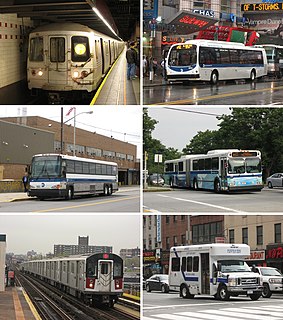
The New York City Transit Authority is a public authority in the U.S. state of New York that operates public transportation in New York City. Part of the Metropolitan Transportation Authority, the busiest and largest transit system in North America, the NYCTA has a daily ridership of 8 million trips.

The W Broadway Local is a rapid transit service of the New York City Subway's B Division. Its route emblem, or "bullet", is colored yellow since it uses the BMT Broadway Line in Manhattan.
The MTA Regional Bus Operations bus fleet is a fleet of buses in fixed-route service in New York City under the "MTA New York City Bus" and "MTA Bus" brands, the former of which includes Select Bus Service routes.
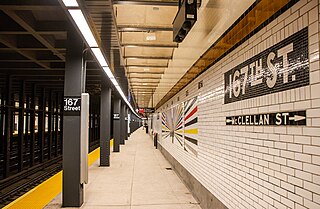
167th Street is a local station on the IND Concourse Line of the New York City Subway. Located at the intersection of 167th Street and Grand Concourse in the Highbridge and Concourse neighborhoods of the Bronx, it is served by the D train at all times except rush hours in peak direction and the B train during rush hours.
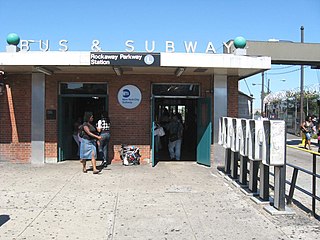
Canarsie–Rockaway Parkway is the southern terminal station of the BMT Canarsie Line of the New York City Subway, and is one of the few grade-level stations in the system. Located at the intersection of Rockaway Parkway and Glenwood Road in the Canarsie neighborhood of Brooklyn, it is served by the L train at all times.
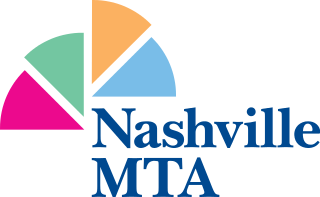
WeGo Public Transit is a public transportation agency based in Nashville, Tennessee. Consisting of city buses and paratransit, the system serves Nashville and Davidson County. Most bus routes serve the downtown transit station, Music City Central. This makes MTA the largest transit agency where most of the bus routes terminate in a Central Business District with no crosstown service. The crosstown services that do not terminate in downtown Nashville are the Wedgewood, the Midtown, the Grassmere/Edmondson Connector, the Bell Road, the Madison Connector, and the Thompson Lane Connector.

The M60 Select Bus Service is a bus route in New York City. It is part of MTA Regional Bus Operations, operated by the Manhattan and Bronx Surface Transit Operating Authority (MaBSTOA) under the New York City Transit brand. The M60 provides service between the Upper West Side of Manhattan and LaGuardia Airport in East Elmhurst, Queens, traveling between boroughs via the RFK-Triborough Bridge. It is the only direct public transit option between Manhattan and LaGuardia Airport.
The Seventh Avenue Line is a public transit line in Brooklyn, New York City. It currently serves the B67 bus of MTA Regional Bus Operations. The B67 is dispatched out of the Jackie Gleason Depot in Sunset Park, Brooklyn.

Select Bus Service is a brand used by the Metropolitan Transportation Authority (MTA)'s Regional Bus Operations for bus rapid transit service in New York City. The first SBS route was implemented in 2008 in order to improve speed and reliability on long, busy corridors.

MTA Regional Bus Operations (RBO) is the surface transit division of the Metropolitan Transportation Authority (MTA). It was created in 2008 to consolidate all bus operations in New York City operated by the MTA. As of February 2018, MTA Regional Bus Operations runs 234 local routes, 71 express routes, and 20 Select Bus Service routes. Its fleet of 5,725 buses is the largest municipal bus fleet in the United States and operates 24/7.

The 165th Street Bus Terminal, also known as Jamaica Bus Terminal, the Long Island Bus Terminal, Jamaica−165th Street Terminal, or simply 165th Street Terminal, is a major bus terminal in Jamaica, Queens. Owned by MTA Regional Bus Operations, the terminal serves both NYCT and MTA Bus lines as well as NICE Bus lines to Nassau County, and was a hub to Green Bus Lines prior to MTA takeover. It is located at 89th Avenue and Merrick Boulevard, near the Queens Library. Most buses that pass through Jamaica serve either this terminal, the Jamaica Center subway station at Parsons Boulevard, or the LIRR station at Sutphin Boulevard.

The LaGuardia Link Q70 Select Bus Service bus route constitutes a public transit line in Queens, New York City, running primarily along the Brooklyn Queens Expressway. It runs between the 61st Street–Woodside station—with transfers to the New York City Subway and Long Island Rail Road—and Terminals B, C, and D at LaGuardia Airport, with one intermediate stop at the Jackson Heights–Roosevelt Avenue/74th Street station. This route is operated by MTA Regional Bus Operations under the MTA Bus Company brand.

MTA Bus Time, stylized as BusTime, is a Service Interface for Real Time Information, automatic vehicle location (AVL), and passenger information system provided by the Metropolitan Transportation Authority (MTA) of New York City for customers of its bus operations under the New York City Bus and MTA Bus Company brands. First tested in late 2010 and officially launched in early 2011, MTA Bus Time was installed in all MTA bus routes in New York City by 2014.

New Technology Train (NTT) is the collective term for the modern passenger fleet of the New York City Subway that has entered service since the turn of the 21st century. This includes the current R142, R142A, R143, R160, R179, and R188 models and the planned R211 and R262 models. Two prototypes, the R110A and R110B, were used to test the features that would be found on all NTT trains today.
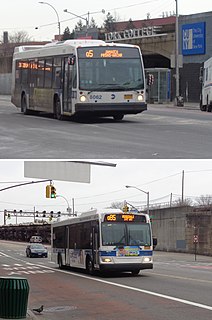
The Q5 and Q85 bus routes constitute a public transit corridor running along Merrick Boulevard in southeastern Queens, New York City. The routes run from the Jamaica Center transit hub and business district to Rosedale, with continued service to Green Acres Mall in Valley Stream, Nassau County. The Q4 and Q84 buses also serve the northern portion of the corridor, before diverging east along Linden Boulevard and 120th Avenue respectively. The Q4, Q5, and Q85 also provide limited-stop service along the corridor. The routes on the corridor mainly serve as feeder routes to New York City Subway services at Jamaica Center–Parsons/Archer station.















